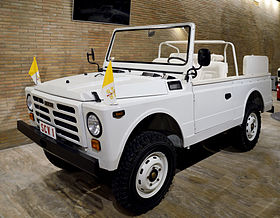Fiat Campagnola
| Fiat Campagnola | |
|---|---|
 | |
| Overview | |
| Manufacturer | Fiat |
| Also called | Zastava AR51/AR55 |
| Production | 1951–1973 |
| Dimensions | |
| Wheelbase | 225 cm (88.6 in) |
| Length | 360 cm (141.7 in) 403 cm (158.7 in) |
| Width | 148 cm (58.3 in) |
| Height | 195 cm (76.8 in) |
| Curb weight | 1,250 kg (2,760 lb) -1,350 kg (2,980 lb) |
The Fiat Campagnola is a heavy-duty off-road vehicle produced by Fiat from 1951 to 1987. Production started in 1951[1] and it was upgraded in 1974. It was inspired by the Willys Jeep.[2]
Fiat 1101 "Campagnola" (1951–1973)
Civilian models
| Model | Engine | Displacement | Power | Fuelsystem |
|---|---|---|---|---|
| 1101 | inline-four ohv | 1,901 cc | 53-63 hp | single carburetor |
| 1101A | inline-four ohv | 1,901 cc | 53-63 hp | single carburetor |
| 1102 | inline-four ohv | 1,901 cc | 40 hp | diesel |
| 1102A | inline-four ohv | 1,901 cc | 43 hp | diesel |
| 1102B | inline-four ohv | 1,901 cc | 51 hp | diesel |
| 1102C | inline-four ohv | 1,895 cc | 47 hp | diesel |
Fiat 1107 "Nuova Campagnola" (1974–1987)
| Fiat Nuova Campagnola | |
|---|---|
 Fiat Campagnola as Popemobile in which Pope John Paul II was victim of an assassination attempt. This vehicle is now in the "Carriage museum" of the Vatican City. | |
| Overview | |
| Manufacturer | Fiat |
| Also called | Renault TRM500[3] |
| Production | 1974–1987 |
| Dimensions | |
| Wheelbase | 230 cm (90.6 in) |
| Length | 378 cm (148.8 in) 403 cm (158.7 in) |
| Width | 158 cm (62.2 in) |
| Height | 195 cm (76.8 in) |
| Curb weight | 1,750 kg (3,860 lb) |
The Campagnola was redesigned for launch in June 1974[4] and in this form produced until 1987.
The new vehicle used the petrol engine of the Fiat 132, but with a longer stroke which increased the capacity to 1,995 cc.[4] - the same enlarged engine turned up in the Fiat 132 itself two years later, albeit with twin overhead camshafts. There was a light alloy cylinder head: instead of the twin overhead camshafts of the 132, the engine in the Campagnola had a single side-mounted camshaft driven by a toothed belt, the valve movement being driven by pushrods and rockers.
As an option, a Sofim 2.5 litre diesel engine was also available.
The large square engine compartment gave easy access to the engine bay which was designed to permit "wading" up to 70 cm deep.[4]
The 57 litre fuel tank was positioned well out of range from rocks and flying stones, under the twin passenger seat beside the driver.[4]
Torsion bars suspended all four wheels, with two shock absorbers for each of the rear wheels and a single one for each of the front wheels. All six shocks used were of identical specification and thus interchangeable.[4] Road testers from the UK commended the smoothness of the ride over rough ground which evidently compared very favourably with that offered by the Land Rover of the time.[4]
A military version was introduced in 1976 (AR76) and in 1979, after a new update, it was called AR76
.
Engines
| Model | Engine | Displacement | Power | Fuelsystem |
|---|---|---|---|---|
| 1107 | inline-four ohv | 1,995 cc | 80 hp | single carburetor |
| 1107 D | inline-four SOHC | 1,995 cc | 60 hp | diesel |
| 1107 D | inline-four SOHC | 2,445 cc | 72 hp | diesel |
Others
Renault derivative
In 1976 the French army was about to replace its Jeeps and several prototype series were made: Peugeot proposed the P4, an adaptation of the Mercedes G-Wagen, powered by the gasoline engine of Peugeot 504. Citroën offered its own version of the Volkswagen Iltis, using the CX Athena engine and renamed as C44. The Renault Campagnola TRM500 was derivative of Fiat Campagnola and used engine of Renault R20. Finally the Peugeot P4 was chosen as new army jeep.[5]
Zastava
The Campagnola was also license-built by Zastava Trucks, in Yugoslavia.
See also
References
- ^ Ackerson, Robert (2006). Jeep CJ 1945-1986. Veloce Publishing Ltd. ISBN 9781904788966.
- ^ "This 1975 Vintage Fiat Campagnola Is Basically an Italian Land Rover Defender". 15 July 2018. Retrieved 17 September 2018.
- ^ "Campagnola Renault TRM500 History". Campagnola.org. Archived from the original on 2011-07-25. Retrieved 2011-01-22.
- ^ a b c d e f "New Cross-country Vehicle from Fiat". Autocar. 141 (nbr 4053): 30. 22 June 1974.
- ^ "CAMPAGNOLA RENAULT TRM500". campagnola.org. Archived from the original on 2011-07-25. Retrieved 2011-01-22.
- v
- t
- e
| Predecessor |
| ||||
|---|---|---|---|---|---|
| Parent |
| ||||
| Subsidiaries and divisions |
|

| Cars | |
|---|---|
| Crossovers/SUVs | |
| Vans |
|
| Pickup trucks | |
| Abarth |
|
(List)
| 1980–2019 |
|
|---|---|
| 1950–1979 | |
| 1920–1949 |
|
| 1899–1919 | |
| LCVs |
- 130 HP
- 28-40 HP
- Mephistofeles
- S74
- S76 Record
- Patriarca 1100
 Category
Category Commons
Commons











